The iPad Air Review
by Anand Lal Shimpi on October 29, 2013 9:00 PM ESTGPU Performance
Since the iPad Air uses the same A7 silicon as the iPhone 5s, it also uses the same on-die GPU as the 5s: IMG’s PowerVR G6430. This is a 4-cluster configuration of IMG’s latest graphics hardware, running at some relatively high frequency. I already went into some detail on the G6430 in our 5s review so I won’t rehash that here, but we’re basically looking at a shift to a more efficient scalar architecture.
I still don’t have confirmations of clock speeds, but I believe we’re looking at a max GPU clock of around 450MHz. As you’ll see from the results below, there’s a small difference in performance between the iPad Air and iPhone 5s in terms of peak GPU performance - implying very similar clocks. The difference is the iPad Air should be able to sustain its max frequency longer than the iPhone 5s can.
| Mobile SoC GPU Comparison | ||||||||||||
| PowerVR SGX 554MP4 | PowerVR G6430 | PowerVR G6430 | ||||||||||
| Used In | iPad 4 | iPhone 5s | iPad Air | |||||||||
| SIMD Name | USSE2 | USC | USC | |||||||||
| # of SIMDs | 32 | 4 | 4 | |||||||||
| MADs per SIMD | 4 | 32 | 32 | |||||||||
| Total MADs | 128 | 128 | 128 | |||||||||
| GFLOPS @ 300MHz | 76.8 GFLOPS | 76.8 GFLOPS | 76.8 GFLOPS | |||||||||
| GFLOPS as Shipping | 68.1 GFLOPS (?) | 115.2 GFLOPS | 115.2 GFLOPS | |||||||||
Since we’re talking about an A7 here and not an X-series SoC, there’s still only a 64-bit wide memory interface. As memory bandwidth is a key enabler of GPU performance I was curious to see how GPU performance compared to the outgoing iPad 4 with its much wider memory interface. Do keep in mind that the A7 does include a large system cache on-die, which can help improve effective memory bandwidth.
GFXBench 2.7
We'll start our GPU performance analysis with a look at low level results using GFXBench/GLBenchmark 2.7. The low level tests, particularly the offscreen ones, should give us some idea as to whether or not there's any increase in GPU frequency for the iPad Air vs. iPhone 5s implementations of A7.
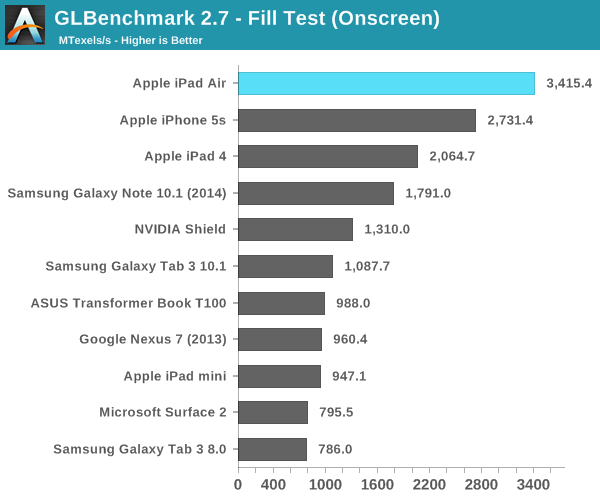
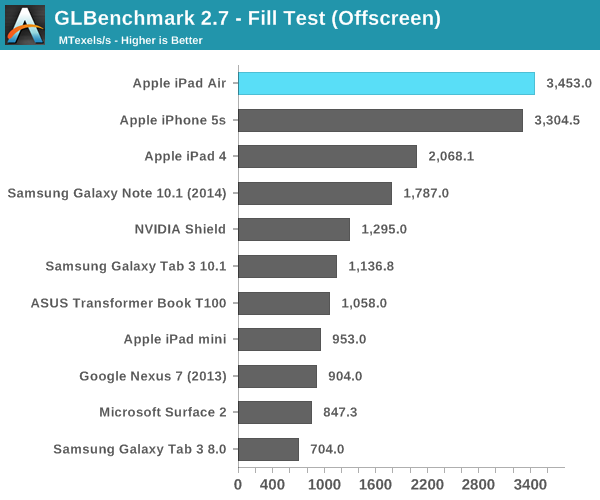
Looking at the fill rate results, there's a 4.5% increase in performance compared to the iPhone 5s. That could be the magnitude of clock increase that we're seeing between A7s. Apple could very well be relying on more thermal headroom in the iPad Air to provide any real world GPU performance advantages over the iPhone 5s.
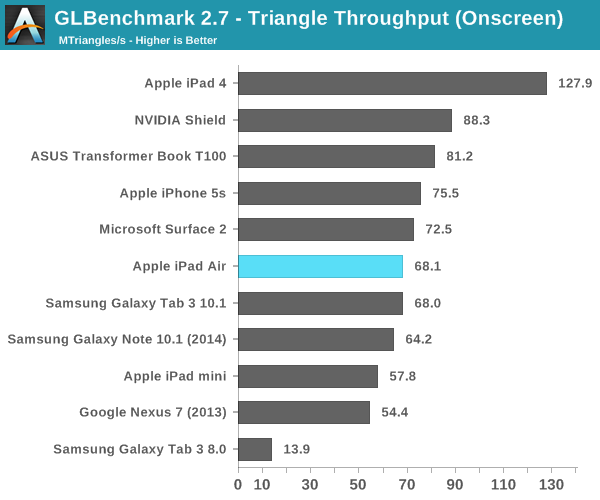

We see an even smaller gap between the Air and 5s in the triangle throughput tests (2.9%). There doesn't seem to be any substantial difference in GPU frequency between A7 implementations here. The regression in triangle rate performance compared to the iPad 4 is explained by differences in how Series 6 and Series 5XT GPUs scale in width. Whereas 5XT replicated nearly the entire GPU for "multi-core" versions, multi-cluster versions of Rogue only replicate at the shader array. The result? We don't see the same sort of peak triangle setup scaling we did back on multi-core 5XT parts. I'm not sure I'm particularly happy with the magnitude of the regression here, but I haven't seen any real world cases where it matters yet.
Next up are the game simulation tests. We'll start with the more strenuous of the two: T-Rex HD.
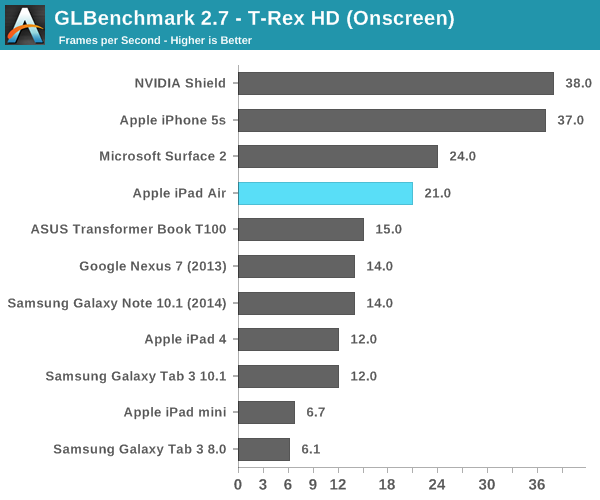
Here we get closer to Apple's claims of a 2x increase in performance. The iPad Air delivers 75% more performance than the iPad 4 in this test. Once again the iPhone 5s pulls ahead but that's because the onscreen tests render at display resolution, which is lower on the 5s.
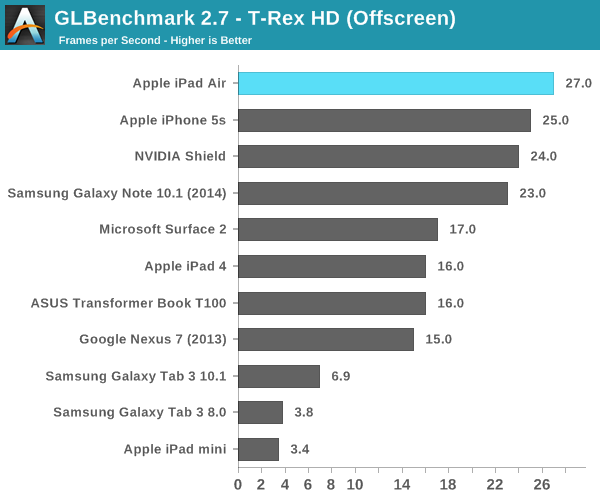
Offscreen performance sees similar scaling: ~69% better performance compared to the iPad 4.
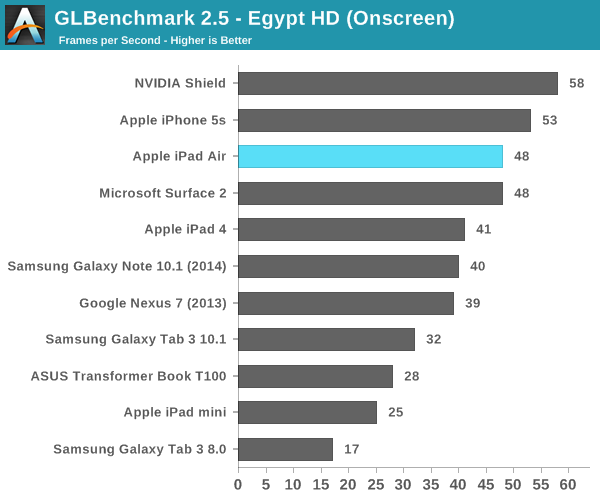
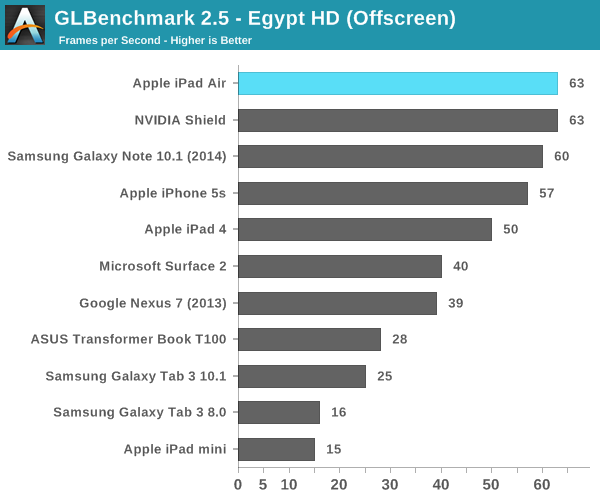
3DMark
We're once again running 3DMark's newest Unlimited mode which does its best to run independently of v-sync and at a standard resolution across all devices. I've also included 3DMark Extreme results below that feature a few more comparison points.
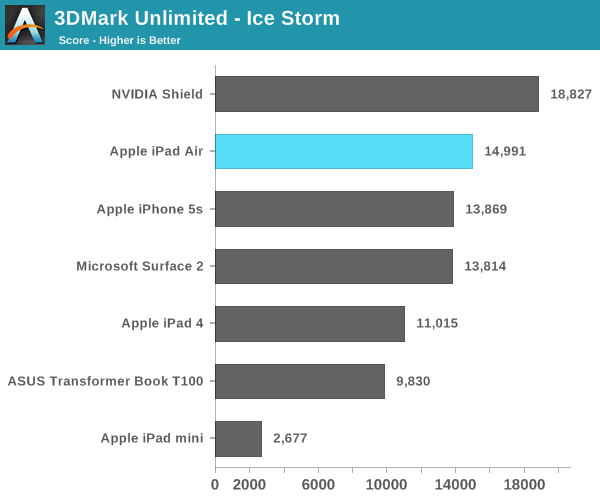
The overall Ice Storm scores show a 36% improvement in performance over the iPad 4 and an 8% increase compared to the iPhone 5s. Given the CPU frequency advantage of the A7 in the Air vs. the iPhone 5s, I'm guessing that's why we're seeing the performance gap we are here.
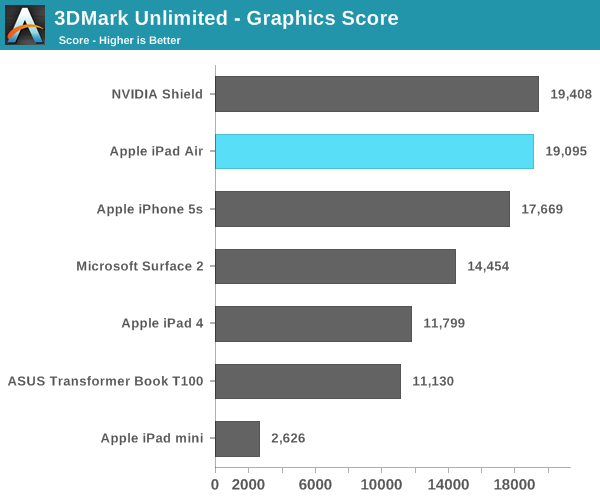
If we focus exclusively on the GPU tests (which themselves are still CPU bound), the iPad Air's performance advantage over the iPad 4 grows to over 60%.
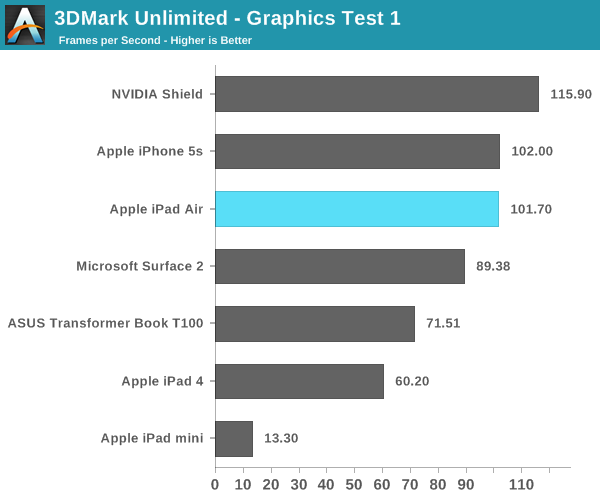
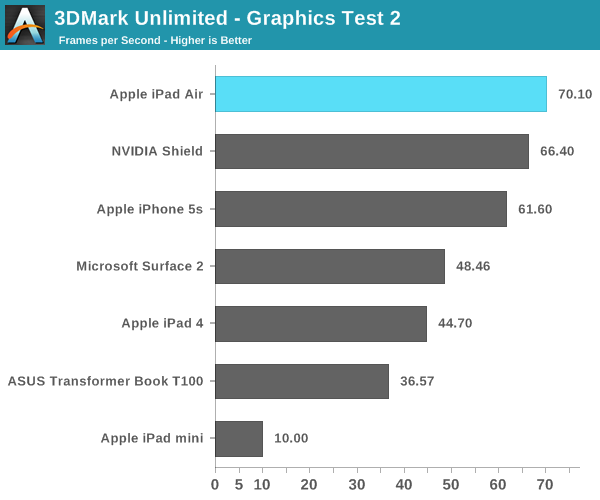
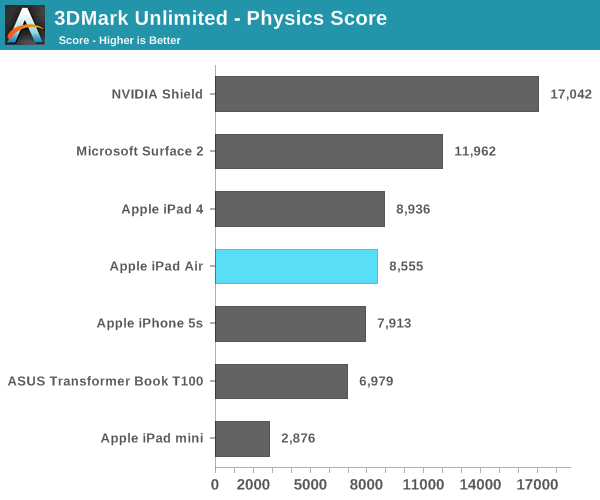
I'm still not entirely sure what's going on with the 3DMark Physics test, but we've seen this two reviews in a row now where Cyclone showed no performance increase at all compared to Swift despite this being largely a CPU test.
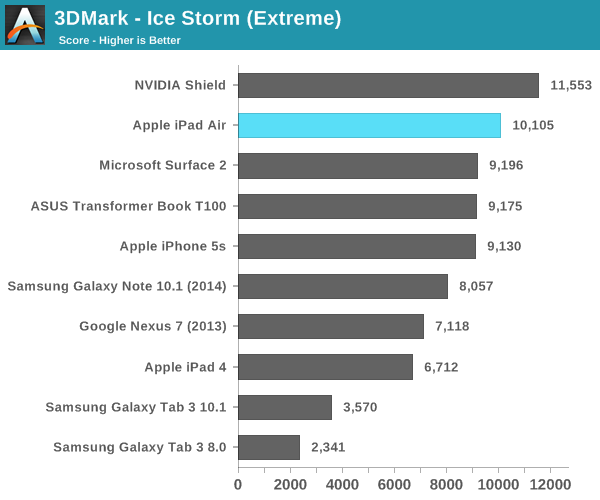
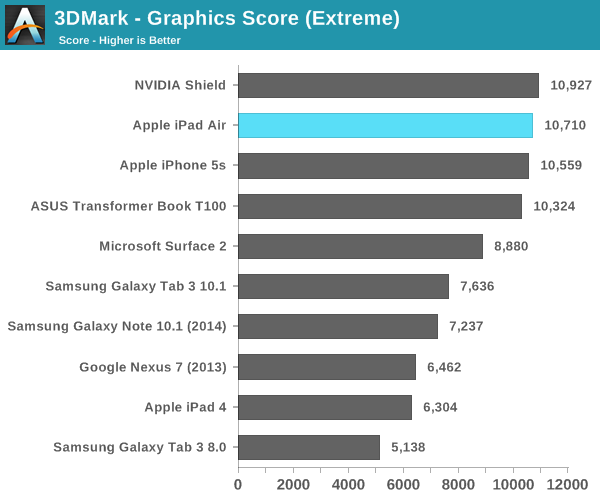
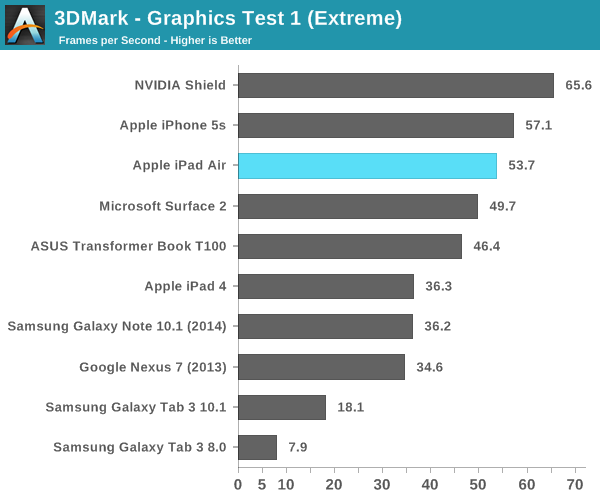
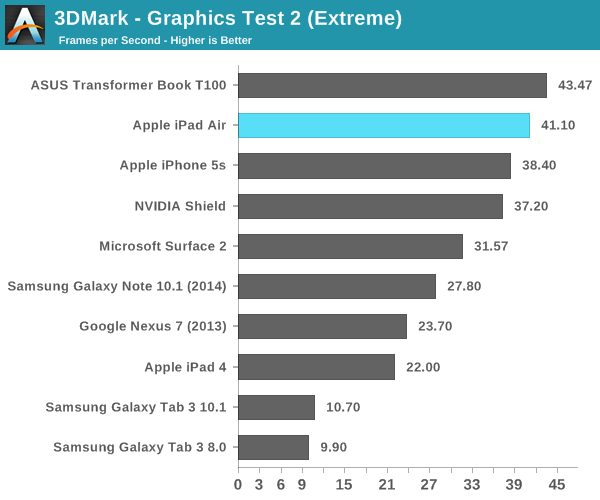

Basemark X
Basemark X is a new addition to our mobile GPU benchmark suite. There are no low level tests here, just some game simulation tests run at both onscreen (device resolution) and offscreen (1080p, no vsync) settings. The scene complexity is far closer to GLBenchmark 2.7 than the new 3DMark Ice Storm benchmark, so frame rates are pretty low.
I'm still having random issues with Basemark X reliably running both on and offscreen tests on iOS 7. Unfortunately I could only get onscreen results for the iPad Air, which came in at 46% faster than the iPad 4. Note the iPad mini and iPhone 5s benefit from having lower native resolutions here, which is why they perform so well.
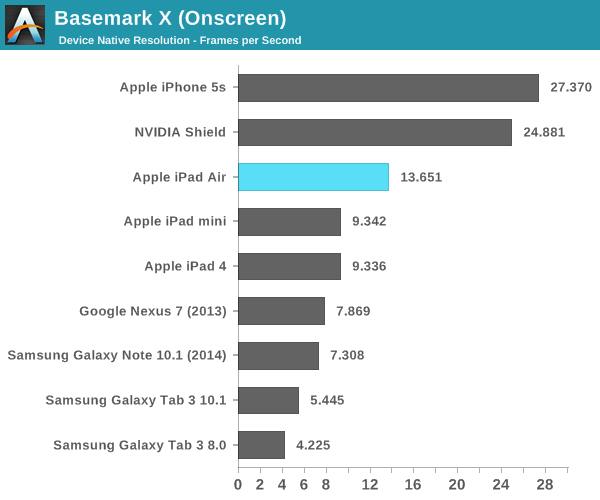










444 Comments
View All Comments
solipsism - Tuesday, November 5, 2013 - link
Spunjji wrote, "o, they're not, but even the most expensive NAND does not cost what Apple are charging."Why would you think they would sell it to you at their bulk component cost? Ridiculous!
Spunjji - Tuesday, November 5, 2013 - link
So what you're saying is that the economics of the situation justifies them fucking the consumer.That's cool, go with it. It's certainly their logic. I'm just reserving my right to call it bullshit.
solipsism - Tuesday, November 5, 2013 - link
Spunjji wrote, "So what you're saying is that the economics of the situation justifies them fucking the consumer."How are you being fucked by choosing whether to buy or not buy? You really need to read up on how a free market works.
ChrisHogg - Wednesday, October 30, 2013 - link
What is that background on the iPad Air? Can you please post the file or the link? Thanks.apaceeee - Wednesday, October 30, 2013 - link
1GB RAM is really deficient in reality. The more resolution it has, the more RAM it request. In fact, 1GB RAM is easily crashed in some APPs even if in iOS6.1.X, How about iOS7 ? I know the processes are false in the background, it's not Android. But the reality is many APPs will take much more RAM than we considered, even if a large PPT opened in QuickOffice HD Pro can crash. I can't believe that the HUGE-RAM-Taking can be fixed in iOS7 .Zoolookuk - Wednesday, October 30, 2013 - link
The 3Dmark physics score is explained as follows: The Physics test is uses Bullet, and practically the whole CPU time is spent in the soft body solver, PSolve_links. If you pull this function out of Bullet and bench it separately, you do see a 2x speed increase [over Swift]. However, once it's inside the physics engine, you see nothing.The result seems to be that if the soft bodies are arranged in memory so that the CPU can access them in a sequential fashion, you get a 2x to 3x increase in speed. This is higher if it can run up the memory, a bit lower if it runs down. The way bullet places the bodies in the memory is a lot more random and they are accesses in a jump-back-and-forth manner. When memory is accessed in this way, all speed gains are lost.
A6 shows none of this behaviour. It is realistic to assume that in the new A7 we see the new prefetch in action, but it cannot gain traction with a random memory access pattern.
Da W - Wednesday, October 30, 2013 - link
I JUST CAN'T STAND THOSE gSHEEPS and Nvidia FANBOIS that blast Anand everytime he posts a review on an Apple or AMD product.GET A FUCKING LIFE PEOPLE!
This is by far the best tech review website i've seen ANYWHERE on the web, and i find the guy goes out of his way to be as neutral and unbiased as one can be!
A good product is a good product. Just because you don't like the company (for whatever reason, as long as you don't work there or are not a stock holder you should just shut the fuck up) doesn't mean the reviewer is bad!
I also find most of these people are Google/Samsung zealots. I wonder if there's a secret google team that spoil anti-apple/microsoft shit everywhere on the web. they sure got the money, and they control the web. I've seen it in politics.
Look i'll make things simple:
1) Apple makes good product and tens of millions of people care about theses products and search the web for reviews for their latest products. Its only natural for a REVIEW SITE to post reviews on the topic.
2) It so happen that AMD's GPU are not pure crap. They heat more than Nvidia this generation, but cost less, they ARE an alternative.
3) I've seen reviews of Windows and Surface on day one here on Anandtech. The review is usualy on par with the market: cute, but doesn't sell.
4) Anandtech usually praise Samsung, HTC and other Android products too.
So all of you people, GET A LIFE. Or a challenge you to build a review site more unbiased that this one. Do it yourself and stop crying.
tipoo - Wednesday, October 30, 2013 - link
A lot of disgruntled iPad 1 owners will tell you lack of RAM is it's achilles heel, I hope this 30% increase in its RAM use with no increase in capacity doesn't hurt it.People saying Mavericks like compression will help: Anand measured how much RAM was in use under load. If it was compressing something, it would have been factored into how much was used. This is no holy grail here.
Justin216 - Wednesday, October 30, 2013 - link
The problem was that the original iPad's memory was somewhat anemic from the get-go, even for the limited apps that were available at release.Since I've yet to have any memory issues on my 5s (iOS7 seems to do pretty good memory management, better than iOS6 did for me on my iP5), so I don't anticipate I'll have any with a new iPad Air.
Would I have liked more? Yep. Should they have added more? Probably. I'm just not overly put off by it having 1GB RAM. Reality is, app devs work within their hardware constraints, and make great use of the specs they have. We've had the Xbox 360 on the market, what, 8 years? It has 512MB RAM, and developers still managed to make great software under those constraints. Apples to oranges there of course, but the basic concept still stands.
Now, if we were talking flagship Android tablets, I'd never buy one with 1GB RAM. For several technical reasons, Android is RAM hungry, and the general experience improves dramatically with more RAM.
Kvaern - Wednesday, October 30, 2013 - link
Time will show if the airpad will become obsolete prematurely because of its ram but those disgruntled iPad 1 users apparently fail to realize you don't both get to be a tech pioneer and get product longevity.